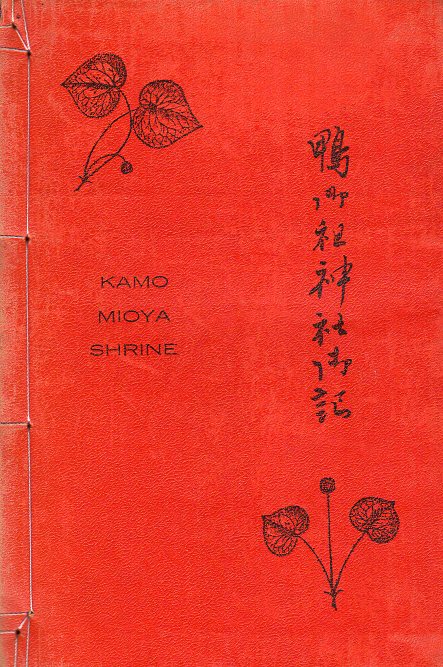
Author: Ponsonby - Fane, Richaed
Title: Kamo Mioya Shrine
Description: Tokyo. J.L. Thompson & Co. Ltd.. 1934. First edition. Quarto. Japanese Sewn Binding. Very good. 151 Pages, Black and white photographs. Kamo Shrine (Kamo-jinja) is a general term for an important Shinto sanctuary complex on both banks of the Kamo River in northeast Kyoto. It is centered on two shrines. The two shrines, an upper and a lower, lie in a corner of the old capital which was known as the "devil's gate" (kimon) due to traditional geomancy beliefs that the north-east corner brought misfortune. Because the Kamo River runs from the north-east direction into the city, the two shrines along the river were intended to prevent demons from entering the city. The Kamo Shrine encompasses what are now independent but traditionally associated jinja or shrines: the Kamo-wakeikazuchi Shrine (Kamo-wakeikazuchi jinja) in Kyoto's Kita Ward, and the "Kamo-mioya Shrine'" (Kamo-mioya jinja) in Sakyo Ward. They are amongst the "Historic Monuments of Ancient Kyoto" which have been designated by UNESCO as a World Heritage Site. The jinja name identifies the clustered kami or deities who are venerated at the Kamo Shrine; and the name refers to the ambit of shrine's encircling woods. The shrine name also references the area's early inhabitants, the Kamo clan, many of whom continue to live near the shrine their ancestors traditionally served. The Kamo are credited with establishing this Shinto sacred place. The formal names of corollary jinja memorialize vital roots in a history which pre-dates the founding of Japan's ancient capital. Although now incorporated within boundaries of the city, the Tadasu no Mori location was a site planning factor.[6] It is theorized that this forest was the primeval forest home of the sacerdotal Kamo clan, who were the exclusive caretakers of the shrine from prehistoric times. The boundaries of today's smaller forest encompasses approximately 12.4 hectares, which are preserved as a national historical site . The woods of this sacred grove are designated by UNESCO as a World Cultural Heritage site along with other Shinto shrines in its environs. SCARCE!.
Keywords: Japanese kamo mioya shrine
Title: Kamo Mioya Shrine
Description: Tokyo. J.L. Thompson & Co. Ltd.. 1934. First edition. Quarto. Japanese Sewn Binding. Very good. 151 Pages, Black and white photographs. Kamo Shrine (Kamo-jinja) is a general term for an important Shinto sanctuary complex on both banks of the Kamo River in northeast Kyoto. It is centered on two shrines. The two shrines, an upper and a lower, lie in a corner of the old capital which was known as the "devil's gate" (kimon) due to traditional geomancy beliefs that the north-east corner brought misfortune. Because the Kamo River runs from the north-east direction into the city, the two shrines along the river were intended to prevent demons from entering the city. The Kamo Shrine encompasses what are now independent but traditionally associated jinja or shrines: the Kamo-wakeikazuchi Shrine (Kamo-wakeikazuchi jinja) in Kyoto's Kita Ward, and the "Kamo-mioya Shrine'" (Kamo-mioya jinja) in Sakyo Ward. They are amongst the "Historic Monuments of Ancient Kyoto" which have been designated by UNESCO as a World Heritage Site. The jinja name identifies the clustered kami or deities who are venerated at the Kamo Shrine; and the name refers to the ambit of shrine's encircling woods. The shrine name also references the area's early inhabitants, the Kamo clan, many of whom continue to live near the shrine their ancestors traditionally served. The Kamo are credited with establishing this Shinto sacred place. The formal names of corollary jinja memorialize vital roots in a history which pre-dates the founding of Japan's ancient capital. Although now incorporated within boundaries of the city, the Tadasu no Mori location was a site planning factor.[6] It is theorized that this forest was the primeval forest home of the sacerdotal Kamo clan, who were the exclusive caretakers of the shrine from prehistoric times. The boundaries of today's smaller forest encompasses approximately 12.4 hectares, which are preserved as a national historical site . The woods of this sacred grove are designated by UNESCO as a World Cultural Heritage site along with other Shinto shrines in its environs. SCARCE!.
Keywords: Japanese kamo mioya shrine
Price: EUR 150.00 = appr. US$ 163.03 Seller: Meijering Art Books
- Book number: 15287
- Book number: 15287